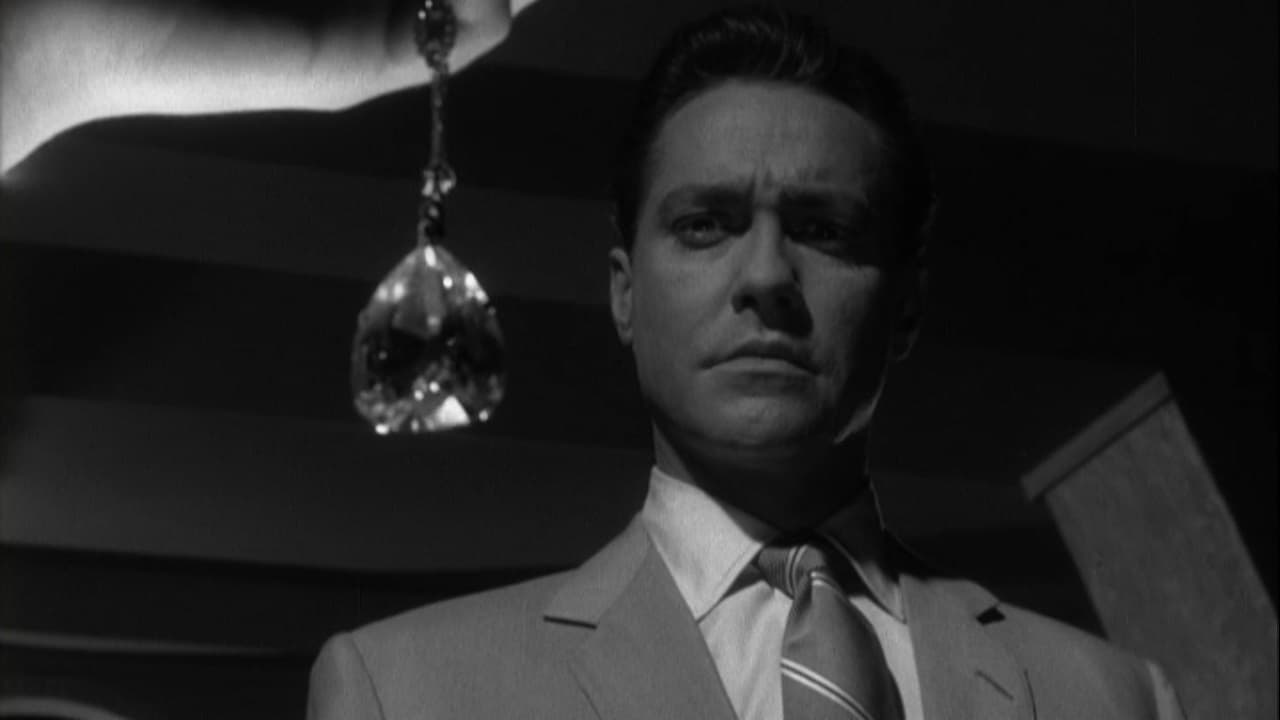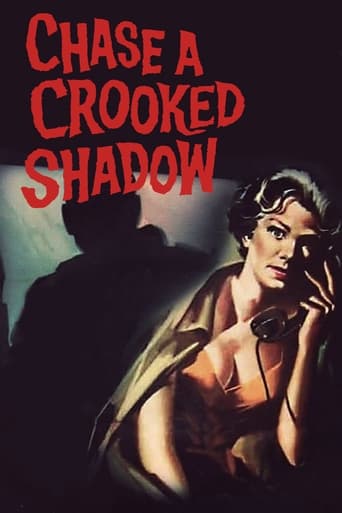SpuffyWeb
Sadly Over-hyped
Fairaher
The film makes a home in your brain and the only cure is to see it again.
Dirtylogy
It's funny, it's tense, it features two great performances from two actors and the director expertly creates a web of odd tension where you actually don't know what is happening for the majority of the run time.
Brendon Jones
It’s fine. It's literally the definition of a fine movie. You’ve seen it before, you know every beat and outcome before the characters even do. Only question is how much escapism you’re looking for.
morrison-dylan-fan
Going to town after New Years day,I found out that a new DVD shop had opened. Along with the usual US blockbusters,I was surprised to find a shelf dedicated to British DVD labels Network and Optimum Releasing,which led to me chasing after the shadow.The plot:After the suicide of her dad, (and also the death of her brother recently) diamond company heiress Kimberley Prescott goes to grieve on the family villa in Spain. Trying to make sense over the loss of two family members, Prescott is shaken from her grief by the arrival of a man,who claims to be her dead brother Ward McKenzie Prescott Jr. Running to police and family,Kimberley is horrified to find everyone disbelieve her that a stranger has stolen Ward's crooked shadow.
View on the film:Unlike their spotless transfers for Ealing Studios and Jacques Becker's work, Optimum Releasing bring out a transfer which features some big lines of dirt,that become distracting when they appear during the close-ups. Following the slithering shadow of Hammer Horror's Psycho-Thriller era and the pre-black gloves psychological bloodless Giallo era, the screenplay by David D. Osborn & Charles Sinclair display a sharp taste for Film Noir fear,via the family villa being turned into a crypt,where Kimberly is left to crack from the ghostly "return" of Ward,who as a Noir loner brings with him unfinished family business.Along with the Psycho-Thriller edge,the writers drive into the jet-set sunset Neo-Noir genre,where Kimberly finds the glittering sun of Spain to brighten up the mind games and suspicions between her and Ward. Before he would count down time with Logan's Run, director Michael Anderson and cinematographer Erwin Hillier keep the timer running with psychological chills, as highly stylised Film Noir shadows surround the villa and hide the family secrets from light. Largely taking place in the Prescott villa, Anderson brings a noose of claustrophobic tension in restrained tracking shots capturing the limited space Kimberly has to uncover the motive behind Ward's "return." Coming in as an outsider with a great, stern Herbert Lom as local cop Vargas, Richard Todd layers on the unsettling, psychopathic, devilish charm as Ward,whilst Anne Baxter brilliantly follows Kimberley slowly cracking under pressure,as Kimberley digs her nails into the crooked shadow.
blanche-2
"Chase a Crooked Shadow" is a 1958 black and white film starring Anne Baxter, Richard Todd, Herbert Lom, Alexander Knox, and Faith Brook. Baxter plays an heiress, Kimberly Prescott, living abroad, whose dead brother (Todd) turns up after being killed in a car accident a year earlier. Except he's not her brother. He brings a woman, Miss Whitman (Brook) with him, sends Kimberly's maid away and brings in his own servants. Kimberly is desperate to reach her architect friend Chandler (Knox) who will know this man isn't her brother, but she can't reach him. And the local chief of police (Lom) seems to side with the fake brother. Well, after all, he does have the correct ID, and the photo Kimberly keeps by her bed has suddenly turned into a photo of the fake!The question is, what do these people want? Is she safe with them, or do they plan to get rid of her? This intriguing, atmospheric drama is excellent, except I've seen so many of these things (it's one of my favorite genres) that I figured the plot out right away. Most people will simply enjoy the ride and the surprises.Baxter looks lovely as the put-upon, desperate heiress, and the role calls for a gamut of emotions, all of which she delivers. Todd and Lom are terrific as well. Really excellent, with very good performances all around.
robert-temple-1
Michael Anderson here has directed a really hair-raising and sinister mystery thriller. The story is most ingenious and creepy: a man, played by Richard Todd, appears one evening at Anne Baxter's villa near Barcelona and pretends to know her intimately. He says he is her brother. But as she knows very well, he is an impostor. Her brother was killed only a year before in a car crash, and she identified his body. Who is this man? What does he want? He won't go away and she calls the local police chief (Herbert Lom) to have him thrown out. But he produces impeccable credentials, a passport, a letter of credit for the bank, and so forth, to prove that he is Baxter's brother. Despite Baxter's increasingly hysterical insistence that this man is an impostor, Lom has to go away, though his suspicions have been aroused, and he keeps an eye on things as they develop. Meanwhile, Todd cannot be dislodged, and he moves into the villa. Baxter's maid vanishes on a sudden holiday and is replaced with Todd's woman friend, played by Faith Brook. Todd also introduces a butler called Carlos. Baxter is understandably in a continual state of fear, surrounded now by aliens in her own house, unable to do anything about it, though she keeps trying. Then the intruders show their hand: it is all about £10 million of missing diamonds which had belonged to Baxter's deceased father, a diamond king of South Africa (Baxter's character is named Kimberley, get it?). Where are the diamonds? But that is not all. There is also the matter of the Last Will and Testament which they present to her, which she is meant to sign, before they drown her. Baxter does an excellent job of becoming increasingly shrill and distraught in this impossible situation. But the main impact of the film comes from the perfect manners of Richard Todd, who is genteel and controlled at all times. This provides the necessary eerie quality to the surreal events of the story. Richard really was such a 'perfect gent'. I knew him late in life, and, like John Mills, he was always impeccably dressed and had the most perfect manners and gentility. They 'don't make 'em like that anymore'.
FilmFlaneur
An early film by the director of Logan's Run and Around the World in 60 Days, this one's main strength is its plot, which spins a fairly gripping early variation on the are-they aren't-they mad scenario which proved such a fruitful ground for British suspense films of the next decade. Those familiar with Taste of Fear (1961) Paranoiac (1963), etc will know how it goes: an isolated victim in peril from immediate family; lingering doubts of the identity of those closest to her; suggestions of beckoning insanity, overtones of incestuousness, obligatory last minute revelations, and so on.At the heart of the film is heiress Kimberley Prescott (Anne Baxter), startled to be confronted by Williams (Richard Todd), purporting to be her late brother Ward, a man favoured with eerily accurate knowledge of their lives together. 'Ward' promptly installs himself in her Greek chateau along with his helper and butler, while Kimberley desperately tries to enlist the help of sympathetic local policemen Vargas (Herbert Lom). Soon it is clear that 'Ward' is interested in learning more about the diamonds missing from her late husbands business, and she grows more and more threatened..At the the beginning of the film we see Williams and his associate Elaine (Faith Brook) running through the last few details of their unspecified deception. Arguably this could have been profitably omitted, as these opening moments remove any real doubts as to the nature of Ward's character. Without the prologue, far more emphasis would have been placed on Kimberley's suspect state of mind, the true nature of the ambiguous imposter's intentions would be far more intriguing, and the resulting psychological drama greatly heightened. As it is, the present film is closer to, say, To Catch a Thief (1955) than Suspicion (1941), with correspondingly less psychological complexity.A talky film like this, with a small number of principals and some exotic location exteriors, stands or falls on the relative few elements of staging. Unfortunately, while blessed with an excellent script, Chase a Crooked Shadow is somewhat handicapped by the two leads. As the interloper 'Wade', the upright Todd is simply too stiff an actor to suggest the subtle menace the part requires, although his withdrawn manner does generate some suspense. The lack of any serious doubt about his intention to deceive never makes of his a particularly sympathetic character, although the extent of his intimate family knowledge is provoking (if never really explained). Straight backed, perfectly tailored, Todd's clipped delivery does induces some suspense as if by default, but the actor never unbends enough to add a necessary third dimension to his characterisation.The other main problem is with Baxter. While sympathetic enough as the put-upon, shrinking heroine in the first part of the film, as events unfold and more elements of her character emerge, she finds it harder to convey the harder edge subsequent revelations demand. The end of the film, while offering an effective last minute twist, simply demands more than the actress can provide. Her final wilting, and lack of larcenous guile, has the effect of making the efforts of law enforcement appear cruel and heavy handed. Morally speaking, they appear to be taking a sledgehammer to crack a nut. In contrast Herbert Lom does his usual excellent job in a supporting role, fleshing out the unspoken concerns of Vargas as best he can.Anderson's film makes little use of the gothic possibilities of the setting, setting a fair number of scenes in well lit rooms or during daylight. Only towards the end, as Kimberley's anxieties reach a peak, does the director seek to trap her more within the shadows and decorative grills of her environment : having the heroine back nervously into a niche for instance ,while her tormentors pass her by; or her firing a spear gun into the threatening darkness of the boathouse (a place at the heart of her secret in more than one sense).The final twist is a celebrated one and is as little telegraphed as one might wish. Anderson's chief achievement here is running the whole narrative so smoothly, and on such a small scale, before springing the final surprise on the audience. If a lot of the result is fairly static, then this can be put down to the casting as well as the characteristics of the script. His next film was to be the far more dynamic Cagney vehicle, Shake Hands With the Devil (1959).

